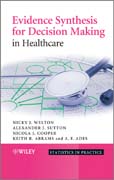
Evidence synthesis for decision making in healthcare
Sutton, Alexander J.
Abrams, Keith R.
Ades, A.E.
Cooper, Nicola J.
In the evaluation of healthcare, rigorous methods of quantitative assessment are necessary to establish interventions that are beneficial, are superior to all alternatives and are cost-effective. Usually one study will not provide answers to these questions and it will be necessary to synthesize evidence from multiple sources. This book aims to outline a coherent approach to such evidence synthesis, for the purpose of decision making. Each chapter contains workedexamples, exercises and solutions drawn from a variety of medical disciplinesEvidence Syntesis for Decision Making intends to provide a practical guide to the appropriate methods for synthesizing evidence for use in analytical decision models. More specifically, it proposes a comprehensive evidence synthesis framework, which models all the available data appropriately and efficiently ina format that can be incorporated directly into a decision model. INDICE: Preface1. INTRODUCTION1.1. The rise of health economics1.2. Decision-making under uncertainty1.3. Evidence-based medicine1.4. Bayesian statistics1.5. NICE1.6. About this book1.7. Summary key points1.8. Further reading2. BAYESIAN METHODS AND WINBUGS2.1. Introduction to Bayesian methods2.2. Introduction to WinBUGS2.3. Advantages and disadvantages of a Bayesian approach2.4. Summary key points2.5. Further reading2.6. Exercises3. INTRODUCTION TO DECISION MODELS3.1. Introduction3.2. Decision tree models3.3. Model parameters3.4. Deterministic decision tree3.5. Stochastic decision tree3.6. Sources of evidence3.7.Principles of synthesis for decision models (motivation for the rest of the book)3.8. Summary key points3.9. Further reading3.10. Exercises4. META-ANALYSISUSING BAYESIAN METHODS4.1. Introduction4.2. Fixed effect model4.3. Random effects model4.4. Publication bias4.5. Study validity4.6. Summary key points4.7. Further reading4.8. Exercises5. EXPLORING BETWEEN STUDY HETEROGENEITY5.1. Introduction5.2. Random effects meta-regression models5.3. Limitations of meta-regression5.4. Baseline risk5.5. Summary key points5.6. Further reading5.7. Exercises6. MODEL CRITIQUE AND EVIDENCE CONSISTENCY IN RANDOM EFFECTS META-ANALYSIS6.1. Introduction6.2. The random effects model revisited6.3. Assessing model fit6.4. Model comparison6.5. Exploring inconsistency6.6. Summary key points6.7.Further reading6.8. Exercises7. EVIDENCE SYNTHESIS IN A DECISION MODELLING FRAMEWORK7.1. Introduction7.2. Evaluation of decision models: one-stage vs two-stage7.3. Sensitivity analyses (of model inputs and model specifications)7.4. Summary key points7.5. Further reading7.6. Exercises8. MULTI-PARAMETER EVIDENCESYNTHESIS IN EPIDEMIOLOGICAL MODELS8.1. Introduction8.2. Prior and posterior simulation in a probabilistic model: maple syrup urine disease - MSUD8.3. A model for prenatal HIV testing8.4. Model criticism in multi-parameter models8.5.Evidence-based policy8.6. Summary key points8.7. Further reading8.8. Exercises9. MIXED TREATMENT COMPARISONS9.1. Why go beyond direct€ head-to-head trials?9.2. A fixed treatment effect model for MTC9.3. Random effect MTC models9.4. Model choice and consistency of MTC evidence9.5. Multi-arm trials9.6. Assumptions made in MTC9.7. Embedding an MTC within a cost-effectiveness analysis9.8. Extension to continuous, rate and other outcomes9.9. Key points9.10. Further reading9.11. Exercises10. MARKOV MODELS10.1. Introduction10.2. Continuous and discrete time Markov models10.3. Decision analysis with Markov models10.4. Estimating transition parameters from a single study10.5. Propagating uncertainty in Markov parameters into a decision model10.6. Estimating transition parameters from a synthesis of several studies10.7. Summary key points10.8. Further reading10.9. Exercises11. GENERALISED EVIDENCE SYNTHESIS11.1. Introduction11.2. Deriving a prior distribution from observational evidence11.3. Bias allowance model for the observational data11.4. Hierarchical models for evidence from different study designs11.5. Discussion11.6. Summary key points11.7. Further reading11.8. Exercises12. EXPECTED VALUE OF INFORMATION FOR RESEARCH PRIORITISATION AND STUDY DESIGN12.1. Introduction12.2. Expected value of perfect information12.3. Expected value of partial perfect information12.4. Expected value of sample information12.5. Expected net benefit of sampling12.6. Summary key points12.7. Further reading12.8. ExercisesAPPENDICESAppendix A1: AbbreviationsAppendix A2: Common DistributionsNOMENCLATURE/NOTATIONIndex
- ISBN: 978-0-470-06109-1
- Editorial: John Wiley & Sons
- Encuadernacion: Cartoné
- Páginas: 320
- Fecha Publicación: 25/05/2012
- Nº Volúmenes: 1
- Idioma: Inglés
